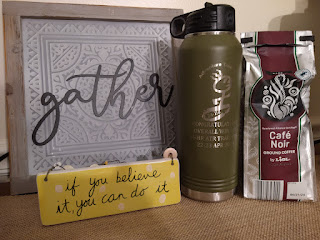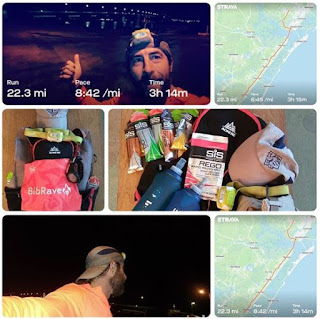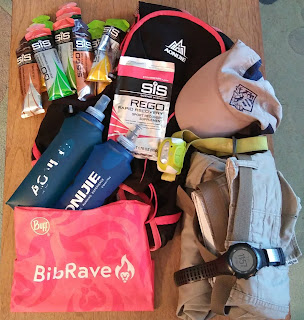The Adventure Trail Run is a combination of timed and distance trail running events held at Prince William Forest Park (National Park Service) in Triangle, VA. This year the event offered 8 hour solo, 4 person relay 24 hour, solo 24 hour, 50k, and 100k options. The course is basically a lollipop design with a 1 mile out and back to a 4 mile loop. The 1 mile out and back section is definitely the most challenging in my opinion and basically my only gripe about the race, so let me get that out of the way. It is probably the most consistently technical section of the course with intermittent stretches of jagged rocks and toe catching exposed roots. It also has many short but steep climbs and descents to deal with. In addition to the technicality of that narrow single track section was the fact that it was also the section of the course where you had to deal with two way traffic of runners. Since this is a relatively small event (around 100 runners) it didn’t present a major problem but with 50k and 100k runners on the course at the same time as the 24 hour runners, it did feel a bit congested to me on a few occasions and made it feel like I couldn’t get into a flow of running. This year I kept on thinking about how that section of the course was like an analogy of Washington DC traffic; drive 70 mph for a few minutes then stop and go for ten minutes and repeat.
I alluded to it earlier about how one motivating factor for me to run the 24 hour Adventure Trail Run again was for a bit of redemption and to hit the missed targets I set for myself last time I ran it. My goal at the race two years ago was to break the course record of 108 miles and I narrowly missed the mark finishing with 103 miles. I’d say that last time I missed that goal primarily due to the fitness level just not being there and a lack of training. Even after failing again (finishing with 100 miles), I still believe the fitness was there this year, but other factors led to my demise. I can reduce those factors to three words, but will expand upon them: weather, diarrhea, and priorities.
Diarrhea: Maybe I don’t need to expand on this one too much or go into too much detail other than to say that I had some gastrointestinal issues for a good portion of the race. So much so that at one point I ran past the single restroom on the course just after the aid station thinking to myself that I don’t have to go too bad only to turn around about 100 feet later because it quickly became an emergency bio break. I felt good without any issues for the first 100k or so, but after that every fart felt like a huge gamble. Honestly, it was probably the worst and most drawn out bout of gastrointestinal issues I’ve ever dealt with during a race. I was eating another anti-diarrhea pill for about 3-4 passes through the aid station, and it didn’t seem to improve the situation. I also can’t really pinpoint what caused it which is troubling. I was eating food I had before and using the same types of gels so I don’t think my calorie sources were the cause. Regardless of the cause, the effect was time. It didn’t slow my running pace much, but frequent bio breaks, as brief as you try to make them, begin to accumulate the minutes and those minutes add up. I’d say I probably used the restroom right after leaving the aid station at least 4-5 times and I made at least 2 emergency trail bio breaks. Even at only about 5 minutes a stop, that’s a half hour of time lost not spent covering ground.
Priorities: The last nail in the coffin for my course record goal was my prioritization of races and motivations. I completed my 14th lap (84ish miles) at about the 19 hour mark leaving me five hours to complete another three laps. By this point I was feeling pretty worked over and wasn’t sure if I could complete another three laps within that time. I thought it was possible, but I knew it would be close, maybe really close. I also knew that if I didn’t complete the third lap by the end of the race I’d finish with 16.5 laps, the exact same distance as my last attempt. I really didn’t want to push super hard for another five hours only to match what I had done last time. Adding to my lack of motivation to push for the last five hours was the fact that after the previous lap I was informed that the leader of the race had just stopped at 13 laps putting me in the lead without anyone really close behind. With all of this information swirling around my groggy brain I was also thinking about my next race, Capital Backyard Ultra, and how I want to be in the best form possible there. Although now it sounds a bit more like an excuse to me, at the time it sounded like a smart move to make and I decided I would take it easy for the remainder of the race. I decided to power hike another lap and then reassess whether it was necessary for me to go back out for another lap to be certain that my first place finish was still secured.
I returned from my power hiked 15th lap with about two hours left on the clock and almost a guarantee that I had first place locked up. With 94ish miles, first place secure, and two hours left in the race I was ready to call it, get cleaned up, and maybe even get a nap before breakfast. I was pretty much decided while sitting by the fire at the aid station explaining this situation to a couple other runners and some race volunteers when the RD, Alex, came over yelling for me to go back out for another lap. I tried to explain that I had Capital coming up in a month and I wanted to just begin the recovery process so I can get another couple weeks of good training in before I start another taper. He wasn’t having it though because one more lap would mean I would hit 100 miles. I fought it for a bit longer, but eventually I gave in and went back out.
As much as I didn’t want to at the time, I was eventually happy that I went back out for another lap to hit the 100 mile mark. Especially when I was chatting with other runners and volunteers at the breakfast after the race. I knew it kinda felt douchey to quit with two hours on the clock, ample time for another lap, just because you know you have first place secured. So in the end, that extra push to go back out for 100 really made it a run I could be more proud of and it certainly felt like a more noble way to win the race then to just put my feet up and wait for the last couple hours.
As much as I didn’t want to at the time, I was eventually happy that I went back out for another lap to hit the 100 mile mark. Especially when I was chatting with other runners and volunteers at the breakfast after the race. I knew it kinda felt douchey to quit with two hours on the clock, ample time for another lap, just because you know you have first place secured. So in the end, that extra push to go back out for 100 really made it a run I could be more proud of and it certainly felt like a more noble way to win the race then to just put my feet up and wait for the last couple hours.
So that explains how I missed my first target for the race, but doesn’t address the second, to serve as a warm up race and fitness/endurance check leading into Capital. While I ran this timed race, I was thinking a lot about expected effort and perceived effort. The first time I ran this race I didn’t think hitting the course record would be too tough, but it was much tougher than expected. This time around, I wasn’t shocked that it was challenging which made it easier to keep fighting towards that goal. Even though I ultimately came up short on my A goal, I’m happy with where I was mentally and physically throughout the race. I was clear with my hierarchy of priorities. This race forced me to push through weather related, physical, and mental challenges. The overnight portion was a great practice night run for Capital, to familiarize myself with running through the night before being shocked by the drowsiness during the first night at Capital. It also gave me one more tool for my sleep derivation fighting toolbox, Five Hour Energy. I brought one bottle of Five Hour Energy not really expecting to need it, but just in case I was feeling drowsy I figured I could test it out. Turns out it helped me tremendously during the wee hours of the morning. Based on my experience with it during this race, I am bringing three bottles to Capital.
I could torture myself with a bunch of “what if”s and “only if”s about missing my A goal like I did last time I ran this race, but I’m not doing it this time around. Once the motivation of chasing that first place spot was gone and reaching my A goal was extremely uncertain, my focus immediately went to Capital. And that’s fine because at Capital and the nature of the backyard race format, whether I reach it or not, I will never not be chasing first place until the race is over.
Scott Snell
14 May 2023
I could torture myself with a bunch of “what if”s and “only if”s about missing my A goal like I did last time I ran this race, but I’m not doing it this time around. Once the motivation of chasing that first place spot was gone and reaching my A goal was extremely uncertain, my focus immediately went to Capital. And that’s fine because at Capital and the nature of the backyard race format, whether I reach it or not, I will never not be chasing first place until the race is over.
Scott Snell
14 May 2023


































